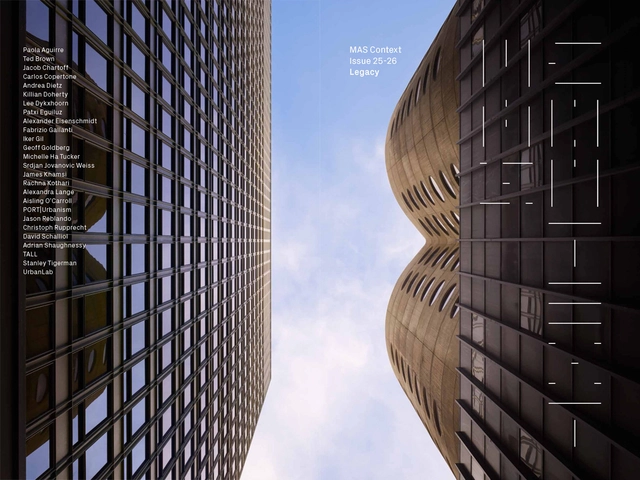
Geometry of light, is a multimedia intervention by Luftwerk in collaboration with Iker Gil, exhibited in October, during the third edition of the Chicago Architecture Biennial, at the Farnsworth House in Plano, Illinois.


Geometry of light, is a multimedia intervention by Luftwerk in collaboration with Iker Gil, exhibited in October, during the third edition of the Chicago Architecture Biennial, at the Farnsworth House in Plano, Illinois.

While its status as an epicenter of architectural production is legendary, Chicago is sometimes overlooked by contemporary architectural debate, forced out of the spotlight by the proliferation of media outlets and educational institutions in the area around New York. However in the latter part of the 20th century and into the 21st, few people have been as devoted to fostering architectural discussion in the city as Stanley Tigerman. In this interview excerpt, originally published by MAS Context as "It’s Not What You Say, It’s What You Do," Iker Gil and Ann Lui speak with the famously antagonistic architect about everything from Chicago, to the New York Five, to the importance of keeping friends at arm's length.
At one point in this interview, Stanley Tigerman asked us: “You know the character you need to be an architect? You need to be brave. You need to be strong. You have to have a very strong backbone. You have to have very thick skin because you’re going to get beat to shit by others, without question. You have to have that quality in you to take the criticism that will come your way no matter what.”
At the core of this advice is the central belief that vigorous debate—including harsh criticism, strong positions, and the prioritization of powerful new ideas even at the cost of one’s own comfort—is essential to the forward movement of architecture.

In architecture circles, it's a sadly familiar trope: a postwar modernist building by a celebrated architect is slated for demolition, and the only people to come to its defense are not the local community, but the architects and critics who can see past the weathered concrete to the ideals within. But despite this familiarity, it's rare to find a critic with first-hand experience as the user of the building in question, and rarer still for them to have experienced it with the unprejudiced eyes of a child. Such is the case with Alexandra Lange, who went to kindergarten at Josep Lluís Sert's Martin Luther King Jr School in Cambridge. In this article from MAS Context, originally titled "Never-Loved Buildings Rarely Stand a Chance: Josep Lluís Sert in Cambridge" and featuring photographs by Lee Dykxhoorn, Lange recounts her experiences of the school and laments its destruction. The latest issue of MAS Context focuses on the theme of "Legacy" - from the legacy we have inherited from our predecessors to the legacy we are leaving for the future.
It’s a detail too perfect, better suited to a novel. Architecture critic goes to kindergarten at modernist school. Years later, she returns to the city of her birth and discovers the school again, surrounded by construction hoardings, on the brink of destruction. Can she save it? Except that was me, and I was too late.

It is safe to say that architects and planners have always been among those striving for utopian ideals through physical space. Just look at the 20th century, when designers converged around the idea of creating new cities for lives that embraced new technologies. We had the Futurists who were obsessed with automobiles, speed and factory cities. We had CIAM and Team 10 who collectively and individually developed the modernist ideals for housing and urban planning. We had Archigram that developed conceptual creations for cities that walked, were inflatable, and could be packed and unpacked in locations all over the world. We had Superstudio, an architecture firm that developed renowned conceptual works of the "total urbanization" of architecture.
As impractical and experimental as some of these proposals were, they initiated a conversation, not only about the physical space that they presented, but the social implications of their designs. The latest issue of MAS CONTEXT, Improbable,tackles these "unlikely futures envisioned in the past that never became present" and explores how, to various degrees, these impossible and improbable agendas projects came to fruition. Join as after the break for a closer look at the new issue.

The new issue of MAS Context, a quarterly publication released by MAS Studio, explores the actual and perceived divisions of space. MAS Context #17: Boundary contains varying in discussions of urban development, forced and naturally occurring segregation, the politics of such separations and ultimately, breaking the boundaries that frame our engagement. Of particular interest in this issue is the philosophical divisions between designers and non-designers and the specialized world that architecture school and the architectural profession construct to define themselves. Through a series of essays, projects, personal accounts and photographs, MAS Context crafts an argument around the boundaries exist in our built and un-built environment - and ways in which we choose to transgress them.
More after the break.

The new issue of MAS Context, a quarterly publication released by MAS Studio takes on the daunting issue of production and consumption impacting cities through the lens of a handful companies operating out of Chicago. Production and consumption have a negative connotation in today's atmosphere of sustainability and conservation but architecture is fundamentally a celebration of the craft of inventing, designing and making. MAS Studio, in collaboration with Chicago-based collective The Post Family, looks critically at the social, environmental, and political implications of consumer culture while celebrating the excellence of production.

On Saturday, October 13th, 2012, MAS Context, in collaboration with NEW PROJECTS, organized the second edition of MAS Context : Analog, a one-day event of presentations, exhibitions and an onsite bookstore in Chicago.